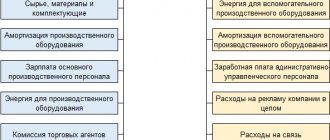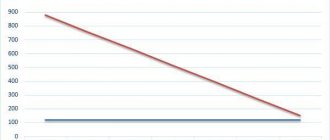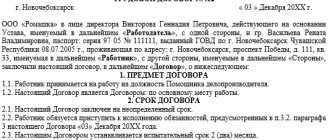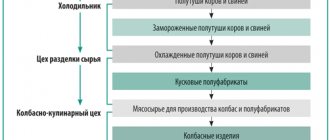Organizations, when calculating depreciation of fixed assets, can use both the linear method of calculating depreciation and non-linear methods. These include the method of writing off value in proportion to the volume of production (work) or the productive method of calculating depreciation .
The procedure for calculating depreciation is prescribed in the order on the accounting policy of the organization. Depreciation starts from the next month after the fixed asset is put into operation and stops in the month of complete write-off or disposal of the object.
When is the method of writing off cost in proportion to the volume of products (works, services) applied?
the method of writing off the cost in proportion to the volume of production (SPO) at its discretion from the permitted methods of calculating depreciation. But such a possibility exists only in accounting - the Tax Code of the Russian Federation does not provide for such a method of writing off the value of property.
IMPORTANT! In accounting, there are 4 methods of calculating depreciation, listed in clause 18 of PBU “Accounting for fixed assets” (approved by order of the Ministry of Finance of Russia dated March 30, 2001 No. 26n): 1 linear and 3 non-linear. There are only 2 methods in the Tax Code of the Russian Federation - linear and nonlinear (Article 259).
SPO belongs to the group of “accounting” non-linear methods, however, it has significant differences with “tax” non-linear depreciation. They are related to the peculiarities of the methodology for calculating the amount of depreciation in the event of an STR:
- to calculate depreciation, it is necessary to have information about the expected volume of products (work, services) during the entire useful life of the property;
- depreciation for the billing period directly depends on the volume of products (works, services) produced using this type of property.
What transformations await the OS classifier in the near future, see the material “The fixed assets classifier may change .
With the “tax” non-linear method, the amount of depreciation is not calculated for a separate type of depreciable property, but depends on the total balance of the depreciation group and established by Art. 259.2 of the Tax Code of the Russian Federation, depreciation standards.
When choosing a depreciation method, priority may be given to SPO in the case when:
- machines, equipment and other property are used intensively for the production of certain types of products (performance of work, provision of services);
- it is possible to definitely establish a connection between the depreciation of property and the volume of products produced (work or service performed).
In any case, the approach to choosing a depreciation method should be carried out in a balanced and justified manner, with the benefits of such a write-off of property value compared with the level of calculation and accounting costs that arise. We'll talk about this in the next section.
The material “Which method to choose for calculating depreciation in tax accounting?” will help you decide on the “tax” depreciation method.
Methods for calculating cost using the FIFO principle
FIFO is the most common method of calculating cost, based on the principle of priority. As mentioned above, the materials supplied first are written off first, hence the abbreviation. Exceptional cases are considered to be cases called assumption, in which expiration dates are more important, and not the earlier time of affixing the goods. Thus, the cost of resources sold first is calculated based on the prices of the remaining products from the earliest delivery. In case of quantitative depletion, inventory and materials are written off at a different cost - the next delivery and then the same.
The mechanism for calculating cost using FIFO can be considered in more detail using the following example:
A musical instrument store sells guitars. There are 20 guitars for 10,000 rubles each and subsequent deliveries in two batches of 30 guitars each - the first for 9,500 rubles, the second for 9,000 rubles. 70 guitars sold for 15,000 rubles. Profit calculation.
At the beginning, 20 guitars are written off at 10,000 rubles = 200,000 rubles. Then - 30 guitars for 9,500 rubles = 285,000 rubles. There are 20 guitars left for 9,000 rubles = 180,000 rubles.
60 X 15000 – (200000+285000+180000) = 235000 (rubles).
This indicator is usually less than the average cost, therefore the amount of income tax is much lower.
How to evaluate the correctness of the chosen depreciation method?
To assess the correctness of the choice of depreciation method, it is necessary to calculate the amount of monthly depreciation for different methods of its calculation and compare the information obtained with the “depreciation policy” of management - its intentions regarding the write-off of property value (the need for its accelerated write-off, the need to evenly transfer the value of property to the cost of production and etc.).
SPO is not a commonly used method of calculating depreciation and is not suitable for all companies. It can be completely replaced by the simplest method to use - linear, in which:
- there is no need to regularly recalculate the amount of depreciation (it is constant from period to period, unless the property is subject to modernization, reconstruction or additional equipment that affects the increase in its value and useful life);
- there is a possibility of convergence between accounting and financial accounting in terms of depreciation charges;
- the change in residual value and accumulated depreciation occurs evenly.
The use of the linear method instead of SPO is justified if the company is expected to receive the same benefit (income) from this type of property throughout its entire service life, and its usefulness decreases gradually (as it wears out).
If we compare SPO with another accounting “depreciation” method - based on the sum of the numbers of years of useful use, then we must proceed from the following features of this method:
- the amount of depreciation is maximum in the first year of operation of the operating system and decreases gradually towards the end of its useful life;
- Depreciation is calculated over the entire useful life.
To compare this method with SPO, it is necessary to compare the calculated depreciation amounts for each period and choose the method in which you can write off the value of property faster - if such a task is provided for in the company’s development strategy.
Similarly, based on calculation, analysis and comparison, the most acceptable and rational method of calculating depreciation is selected between SPO and the reducing balance method - another “accounting” non-linear method.
Study the methods of calculating depreciation using the materials on our website:
- “Formula and example of the reducing balance method of depreciation”;
- “How to correctly apply the cumulative depreciation method?”.
2.3. Accounting for depreciation of fixed assets
The cost of fixed assets is repaid by calculating depreciation. Depreciation is calculated over the useful life.
Useful life is the period during which the use of an item of fixed assets is intended to generate income or serve to fulfill the objectives of the enterprise.
The useful life of an object is determined when it is accepted for registration. For this purpose, either centralized data or from the technical conditions of the object are used.
In the absence of such data, to determine the useful life, the following are taken into account:
— the expected life of the facility in accordance with the expected productivity;
— expected physical wear and tear depending on the operating mode, natural conditions, natural conditions, the influence of an aggressive environment, and the repair system;
— regulatory and other restrictions on the use of this object (for example, rental period).
You can use Classification
If the useful lives of parts of a fixed asset differ insignificantly, then they must be taken into account all together as one object (from 2006). In this case, the materiality criterion is established in the accounting policy, for example, 5%.
Depreciation for accounting purposes is calculated in one of the following ways:
Method of writing off cost in proportion to production volume: calculation example
Let's look at an example of how to calculate depreciation using the SPO method.
Example
The company produces metal components for production equipment according to customer requests. For these purposes, in February 2021, a lathe with electronic numerical control was purchased and put into operation at an initial cost of RUB 3,000,000.
Taking into account the technical resource and productivity of this machine, it is planned to produce 300,000 units of products over its entire useful life.
In March and April 2021, 2,500 and 3,200 units were produced on this machine. products, respectively, and in May the machine was idle due to the lack of requests from the customer for this type of product. Let us determine the amount of depreciation in the indicated months:
In March: RUB 3,000,000. / 300,000 units × 2,500 units = 25,000 rub.
In April: RUB 3,000,000. / 300,000 units × 3,200 units = 32,000 rub.
In May: RUB 3,000,000. / 300,000 units × 0 units = 0 rub.
The example shows that with the SPO method, the write-off of the value of property can be accelerated (if the property is used in an intensive, multi-shift mode) or may not be carried out at all (if there are no orders, demand for this type of product has fallen, etc.). In a situation of persistent instability of orders, it becomes unprofitable to use open source software.
Disadvantages of the FIFO principle
In addition to the positive properties, the method also has disadvantages, these include:
- Inflation is not taken into account: when an organization has a tendency to unevenly spend resources, and the cost of the 1st batch is written off for products that were received at a higher cost (increase due to inflation and other reasons) - the total financial results may be overestimated, this has negative consequences for enterprises;
- Overestimation of financial indicators and tax payments. In accounting using the FIFO method, uneven consumption of materials can increase the amount of tax deductions that the company pays;
- Incorrect figures for managing and planning amounts for the organization’s expenses. The manager may draw up an incorrect policy for the development of the organization, due to receiving inflated data, this will negatively affect the work of the enterprise.
FIFO must be taken into account in the process of financial planning and development of enterprise policy for subsequent periods.
The impact of legislative changes on the choice of depreciation method
Legislators have simplified certain aspects of calculating and calculating depreciation of property for companies that have the right to conduct accounting and prepare reports in a simplified form (Order of the Ministry of Finance of the Russian Federation dated May 16, 2016 No. 64n, which entered into force on June 20, 2016).
IMPORTANT! Small enterprises and non-profit companies with annual revenue of no more than 3 million rubles have the right to use simplified methods of accounting (including simplified accounting). (with the exception of certain categories of non-profit organizations), as well as companies that are residents of Skolkovo (letter of the Ministry of Finance of Russia dated December 27, 2013 No. 07-01-06/57795).
From June 20, 2016, these companies have the right to:
- do not include in the initial cost of fixed assets the costs associated with their acquisition (valuing the property at the price of the supplier (including installation)) - they can be immediately included in the costs of ordinary activities in full during the period of their implementation;
- Depreciation of fixed assets is calculated once a year on December 31 (or during the year at the choice of the company).
For more information about the innovations of Law No. 64n, see the material “Calculation of depreciation once a year and other innovations for those who have access to simplified accounting .
These innovations make it possible to quickly write off the cost of property (including using the SPO method), since part of the costs is included in expenses immediately, without including them in the initial cost.
The legally mandated ability to charge depreciation once a year reduces accounting calculations, although more frequent calculations may be necessary for internal financial reporting and property tax purposes.
These innovations do not have a direct impact on the efficiency of using a particular depreciation method, although they help reduce depreciation amounts and the frequency of their calculation. And to select SPO as one of the possible methods of writing off the value of property, an assessment, preliminary calculations and justification are required.
How to avoid differences in accounting and tax accounting when writing off the value of property, see the material “A way to take into account fixed assets worth from 40 to 100 thousand rubles in tax accounting, avoiding differences with accounting .
Advantages of the FIFO principle
This method has its positive properties or advantages:
- Simple accounting. The method significantly reduces calculation time and helps to cope with a large amount of residual products during the last reporting period;
- Convenient to use in organizations, where initially received resources are spent at the very beginning. FIFO is more profitable and convenient when the “assumption” made by the accountant when using the method is appropriate;
- The best indicators are attracting investment resources. FIFO is the most convenient and profitable accounting method if the head of an organization is involved in attracting investors or receiving a loan for development.
FIFO method in 1C UT
In 1C Trade Management, the FIFO method is used:
- According to classic patrionic accounting, when the system stores information about the price of all batches received for all receipts. The principle also encourages the disposal of goods in a sequential order, starting with the earliest batch.
- With advanced cost accounting analytics, when the calculation of product balance is expressed quantitatively. Then comes the determination of the valuation of the balance at the end of the month, the weighted average, equal to the calculation of prices according to FIFO.
At the same time, the sizes and prices for the remaining products are lined up in order: from the last batch, because, following the FIFO logic, the initially received goods have already been written off.
Next, the volumes of goods removed from the warehouse during the month are determined. The price of received goods is determined, taking into account the price of the initial goods from the balance, then the price of the remaining goods at the end of the month, which was calculated according to the FIFO principle, is subtracted from this indicator. This indicator is the cost of writing off monthly production.
The following formulas are also used:
- The write-off price of a unit of goods = the price of products (during the month)/number of products disposed of during the month.
- Cost of shipment = unit cost of goods X number of goods to be written off.





